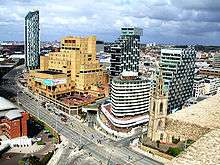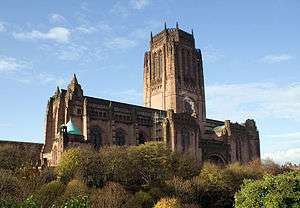Liverpool John Lennon Airport
Liverpool John Lennon Airport (IATA: LPL, ICAO: EGGP) is an international airport serving Liverpool, England. Its CAA Public Use Aerodrome Licence Number is P735. On the outbreak of World War II, the airport was operated by the RAF and known as RAF Speke. The airport is within the City of Liverpool on the banks of the estuary of the River Mersey some 6.5 nautical miles (12.0 km; 7.5 mi) southeast of the city centre.[2] Originally called Speke Airport, the airport was renamed after Liverpudlian musician John Lennon of the Beatles in 2001. Scheduled domestic, European, and North African services are operated from the airport.
Liverpool John Lennon Airport | |||||||||||
|---|---|---|---|---|---|---|---|---|---|---|---|
 | |||||||||||
.jpg) | |||||||||||
| Summary | |||||||||||
| Owner | Peel Airports | ||||||||||
| Operator | Liverpool Airport Ltd.[1] | ||||||||||
| Serves | Liverpool | ||||||||||
| Location | Liverpool, England, UK | ||||||||||
| Focus city for | |||||||||||
| Elevation AMSL | 81 ft / 25 m | ||||||||||
| Coordinates | 53°20′01″N 002°50′59″W | ||||||||||
| Website | www | ||||||||||
| Map | |||||||||||
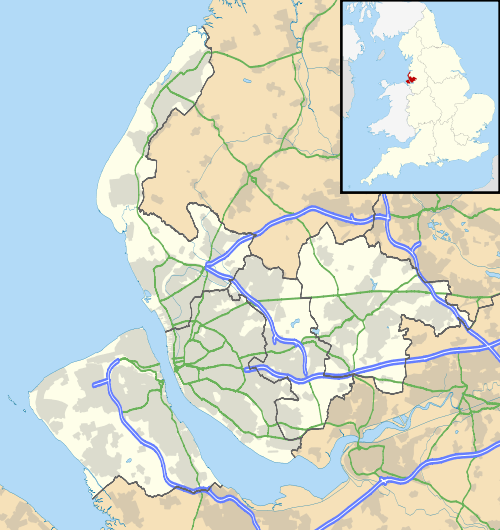 EGGP Location in Merseyside | |||||||||||
| Runways | |||||||||||
| |||||||||||
| Statistics (2018) | |||||||||||
| |||||||||||
Between 1997–2007, the facility was one of Europe's fastest-growing airports, increasing annual passenger numbers from 689,468 in 1997 to 5.47 million in 2007.[3] Despite passenger numbers having decreased to just over 4.8 million in 2016, this was an 11.1% increase on the 2015 total, making it the 12th-busiest airport in the UK. The airport served 4.95 million passengers in 2017, an increase of 3% over 2016. The airport handled just over 5 million passengers 2018.[4]
History
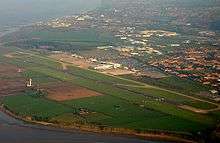

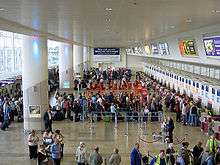
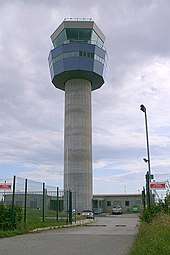
Imperial Airways
Built in part of the grounds of Speke Hall, Liverpool (Speke) Airport, as the airport was originally known, started scheduled flights in 1930 with a service by Imperial Airways via Barton Aerodrome near Eccles, Salford and Castle Bromwich Aerodrome, Birmingham to Croydon Airport near London. The airport was officially opened in mid-1933.[5] By the late 1930s, air traffic from Liverpool was beginning to take off with increasing demand for Irish Sea crossings, and a distinctive passenger terminal, control tower and two large aircraft hangars were built.[6]
Second World War
At the beginning of 1937 Liverpool City Council leased between 70 and 110 acres of their Speke Estate on a 999-year lease to the Air Ministry. The price included at all times the use of Speke Airport next to the shadow factory site. The LMS Railway provided a siding. Erection of the building was planned to take 30 weeks and when complete it would provide employment for more than 5,000 people. It was to be managed by Rootes Securities on behalf of the Air Ministry. Work started Monday 15 February 1937.[7]
During the Second World War, Speke was requisitioned by the Royal Air Force and known as RAF Speke. Rootes built in a "shadow factory" by the airport Bristol Blenheims and 1,070 Handley Page Halifax bombers.[8] Lockheed Aircraft Corporation assembled many types of planes at the airport, including Hudsons and Mustang fighters, that had been shipped from the United States in parts to Liverpool Docks. The airport was also home to the Merchant Ship Fighter Unit.[5]
On 8 October 1940 (one day before John Lennon's birth), Speke was witness to what is thought to be the fastest air-to-air combat "kill" in the Battle of Britain and possibly of all time. Flight Lieutenant Denys Gillam took off in his Hawker Hurricane from Speke to be confronted by a Junkers 88 passing across him. He shot the Junkers down while his undercarriage was still retracting, and, along with Alois Vašátko and Josef Stehlík, all of 312 Squadron, was credited with the kill. The moment has been caught in a painting by Robert Taylor called Fastest Victory.[9][10]
Civil airport
Normal civil airline operations resumed after VE-day and passengers increased from 50,000 in 1945 to 75,000 in 1948, remaining ahead of Manchester Airport. Ownership by the Ministry of Aviation proved to be a drag on the airport's progress thereafter and Manchester gained the lead from 1949, resulting in Liverpool's loss of the only ground-controlled radar approach unit available to North West airports, further hampering operation.
During the post war years, Speke Airport hosted an annual air display in aid of the Soldiers, Sailors, and Air Force Association, a charity for veterans. The displays were immensely popular and attracted a huge crowd. On one such occasion on 21 May 1956 sadly tragedy struck with the death of Léon Alfred Nicolas "Léo" Valentin billed as the Birdman when his balsa wood wings struck the opening of the aircraft from which he was exiting and he was hurtled into an uncontrollable spin. He attempted to deploy his emergency parachute but it became entangled and 'roman candled' leaving Leo to fall to his death. The local newspaper headlined the story with "The world has been robbed of a daring personality". Ironically, a few years earlier Valentin had been attributed with discovering the free-fall stable position still used by sports parachutists today for safe deployment.
New runway
The city took over control of the airport on 1 January 1961 and prepared development plans. In 1966, a new 7,500 ft (2,286 m) runway was opened by Prince Philip on a new site to the southeast of the existing airfield. It enabled the airport to be open for business around the clock and is in use to this day. Control of the airport transferred to Merseyside County Council from Liverpool Corporation in the mid-1970s and then, ten years later, to the five Merseyside councils following the abolition of Merseyside County Council. In 1982, Pope John Paul II visited and met crowds at the old Liverpool airport.
Southern Terminal (1986)
A modern passenger terminal adjacent to the new runway opened in 1986 followed by the closure of the original 1930s building.[11]
The original terminal building dating from the late 1930s, famously seen on early television footage with its terraces packed with Beatles fans, was left derelict until converted into a hotel, opening in 2001, preserving its Grade II listed Art Deco style. It was part of the Marriott chain of hotels, but is currently the Crowne Plaza Liverpool John Lennon Airport Hotel after a renovation in August 2008.[12] The former apron of the terminal is also listed and retained in its original condition, although it is no longer connected to the airport or subject to airside access control. It is the home of several aircraft, including BAe Jetstream 41 prototype G-JMAC and Bristol Britannia G-ANCF, preserved by the Speke Aerodrome heritage Group. The two art-deco-style hangars that flank the terminal and apron have also been converted for new uses: one is now a David Lloyd leisure centre, the other the headquarters of the Shop Direct Group, called Skyways House.[12][13][14][15]
In 1990 the airport was privatised, with British Aerospace taking a 76% shareholding in the new company. Subsequently, the airport has become a wholly owned subsidiary of Peel Holdings.[5] In 2000, work on a £42.5 million passenger terminal began, tripling its size and passenger capacity, completed in 2002. There have since been further extensions. The airport's strategy is to cater largely for 'low cost' operators, and consequently the layout of the terminal and gates requires passengers to walk unprotected from the weather to and from passenger aircraft. Destinations served are throughout Europe, the 2007 scheduled services to the United States and Canada having been withdrawn.
Liverpool John Lennon Airport (2001)
In 2001, 21 years after his death, the airport was renamed in honour of the Beatles' John Lennon, becoming the first airport in the UK to be named after an individual.[16] A 7 ft (2.1 m) tall bronze statue stands overlooking the check-in hall. On the roof is painted the airport's motto, a line from Lennon's song "Imagine": "Above us, only sky."[17] In 2005 the Yellow Submarine, a large-scale work of art, was installed on a traffic island at the entrance to the airport. A permanent exhibition of The Beatles in India's photographs made in 1968 at the Ashram of Maharishi Mahesh Yogi, (founder of the Transcendental Meditation technique), by Paul Saltzman can be seen above the retail units in the departure lounge.[18] In 2005, a brand-new apron exclusively for easyJet was constructed to the east of the terminal with six stands and a pier with six boarding gates.
In September 2006 reconstruction started on the main runway and taxiways. This was the first time the runway had been reconstructed (as opposed to resurfaced) since it was opened in 1966. This work was completed in 2007.[19] In addition to runway and shoulder work was the upgrade of the 40-year-old airfield group lighting with a new system, intended to upgrade the runway to ILS Category III standards.[19]
In 2007 construction of a multi-level car park[20] and a budget Hampton by Hilton Liverpool/John Lennon Airport started. The hotel opened in October 2009.[21] In June 2010 Vancouver Airport Services announced that it reached an agreement with The Peel Group to acquire 65% share in its airports, including Liverpool.[22] Airside improvements include additional retail units and a more advanced security area aiming at reducing waiting times, completed in autumn 2010.[23]
April 2014 saw Peel repurchase the 65% stake it had sold in the airport giving it 100% ownership once more.[24] In March 2016, Peel sold a 20% stake in the airport to Liverpool City Council for a reported £12m. This valued the airport at £60m.[25]
A master plan is in place to be completed by 2030 which plans for the airport to grow significantly. This includes new terminal buildings and the introduction of permanent long-haul services, as well as growing passenger numbers from 5 million a year to 7.8 million.[26][27]
Airport directors
Captain Harold James Andrews was appointed as the first Airport Manager in July 1932, and he was effectively the first full-time professional co-ordinator for the whole project. Jack Chadwick took over many of the management functions post-war until 1961. That year there was a traffic increase of 42%, attributed to the first airport marketing campaign initiated by the new Airport Director, Wing Commander H.W.G.Andrews.[28]
In the late 1960s, Brian Trunkfield MBE was a much-respected Assistant Director, and Keith Porter took over as Airport Director in the days when The Beatles were regular passengers.[29] Chris Preece, a former executive of British Aerospace, was Airport Director during much of the British Aerospace years of ownership, replaced by Rod Rufus and then Rod Hill, who brought in Direct Holidays, part of the MyTravel Group on a commercial deal which was to prove the market for easyJet. Neil Pakey took over as Managing Director in 2002, taking the airport through its major passenger growth years and renaming of it to John Lennon Airport.
On selling the airport to Vancouver Airport Services in 2010, the former Operations Director for Vancouver Airport, Craig Richmond, took over, and on 1 March 2013, Matthew Thomas, also from Vancouver Airport Services (by then renamed Vantage Airport Group), was appointed to the role.[30] Andrew Cornish held the CEO position from September 2014 until the end of June 2017.[31] John Irving became the new CEO with effect from 12 March 2018.[32]
Airlines and destinations
The following airlines operate regular scheduled and charter flights to and from Liverpool:[33]
| Airlines | Destinations |
|---|---|
| Blue Air | Bucharest |
| easyJet | Alicante, Amsterdam, Barcelona, Belfast–International, Berlin–Schönefeld, Faro, Fuerteventura, Geneva, Isle of Man, Jersey, Kraków, Lanzarote, Larnaca, Madrid, Málaga, Nice, Palma de Mallorca, Paris–Charles de Gaulle, Tenerife–South, Venice Seasonal: Antalya, Bodrum, Bordeaux, Dalaman, Grenoble, Nantes, Naples, Palermo, Pula, Rhodes, Salzburg, Zakynthos |
| Loganair | Isle of Man |
| Ryanair | Alicante, Barcelona, Copenhagen, Cork, Derry, Dublin, Faro, Fuerteventura, Knock, Kraków, Lanzarote, Málaga, Malta, Marrakesh, Paphos, Porto, Poznań, Prague, Sofia, Szczecin, Tenerife–South, Vienna, Vilnius, Warsaw–Modlin, Wrocław Seasonal: Bari, Bergerac, Corfu, Ibiza, Palma de Mallorca, Reus |
| Widerøe | Bergen |
| Wizz Air | Bacău, Bucharest, Budapest, Gdańsk, Iași, Katowice, Varna, Warsaw–Chopin |
Additionally in winter, many seasonal charter flights run from Liverpool John Lennon Airport to airports in Lapland and to Akureyri Airport in Iceland via tour operators that charter different airlines.[34][35]
Statistics
Passengers and aircraft movements
| Number of passengers[3] | % Change YoY | Number of movements[3] | % Change YoY | |
|---|---|---|---|---|
| 1997 | 689,468 | - | 83,354 | - |
| 1998 | 873,172 | 86,871 | ||
| 1999 | 1,304,959 | 75,489 | ||
| 2000 | 1,982,711 | 76,257 | ||
| 2001 | 2,253,398 | 74,659 | ||
| 2002 | 2,835,871 | 74,313 | ||
| 2003 | 3,177,009 | 84,405 | ||
| 2004 | 3,353,350 | 85,393 | ||
| 2005 | 4,411,243 | 92,970 | ||
| 2006 | 4,963,886 | 91,263 | ||
| 2007 | 5,468,510 | 86,668 | ||
| 2008 | 5,334,152 | 84,890 | ||
| 2009 | 4,884,494 | 79,298 | ||
| 2010 | 5,013,940 | 68,164 | ||
| 2011 | 5,251,161 | 69,055 | ||
| 2012 | 4,463,257 | 60,270 | ||
| 2013 | 4,187,439 | 55,839 | ||
| 2014 | 3,986,654 | 52,249 | ||
| 2015 | 4,301,495 | 55,905 | ||
| 2016 | 4,778,939 | 62,441 | ||
| 2017 | 4,901,157 | 56,643 | ||
| 2018 | 5,042,312 | 59,320 |
Route statistics
| Rank | Airport | Total passengers | Change 2017/ 18 |
|---|---|---|---|
| 1 | 498,603 | ||
| 2 | 380,437 | ||
| 3 | 287,207 | ||
| 4 | 268,490 | ||
| 5 | 255,659 | ||
| 6 | 240,513 | ||
| 7 | 225,682 | ||
| 8 | 220,517 | ||
| 9 | 197,740 | ||
| 10 | 135,030 | ||
| 11 | 124,449 | ||
| 12 | 102,975 | ||
| 13 | 94,964 | ||
| 14 | 87,697 | ||
| 15 | 85,738 | ||
| 16 | 74,753 | ||
| 17 | 74,595 | ||
| 18 | 71,757 | ||
| 19 | 70,915 | ||
| 20 | 68,304 |
Ground transport
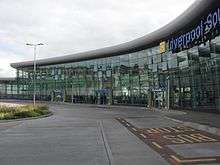
Liverpool John Lennon Airport is within Merseytravel Area C, for local public transport tickets. Plusbus tickets are also available. The Arriva North West 500 route to/from Liverpool city centre is now the quickest way to Liverpool South Parkway and Liverpool One bus station and now extends to Widnes and Runcorn.[37]
Road
The airport has several on-site car-parks[38] and is accessible from the A533 / Runcorn Widnes Bridge to the south, and from the M57 and Knowsley Expressway to the north.[39]
Rail
The nearest station is the Merseyrail Hunts Cross at 2.2 miles away, which is served by a direct bus service to the airport by the Arriva North West 89 service. Merseytravel replaced Garston and Allerton stations with Liverpool South Parkway at 2.9 miles from the airport at a cost of £32 million. Regular bus services, 80A, 86A & 500, operate between the Airport and the station, operated by Arriva North West.
Bus and coach
Regular bus services link the airport with surrounding urban areas. Most buses that run to the airport are operated by Arriva North West, they connect local urban areas to the airport such as St Helens, Bootle, Halewood, Runcorn, Widnes, Huyton, Garston and Liverpool City Centre Liverpool One bus station[40] Arriva operates a 24-hour 86A service to the airport from Liverpool city centre via Penny Lane and Liverpool South Parkway.[41] Merseytravel also runs a service from the airport (3A/3B) which terminates at Huyton Industrial Estate, the service is operated by Selwyns Travel. In 2018 ArrivaClick commenced servicing the airport.[42]
Facilities
Hotels
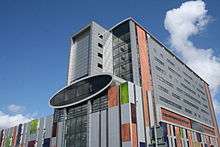
The original terminal building dating from the late 1930s, famously seen on early television footage with its terraces packed with Beatles fans, was left derelict for over a decade after being replaced in 1986. It was renovated and adapted to become a hotel, opened for business in 2001, preserving its Grade II listed Art Deco style. It was part of the Marriott chain of hotels, but is currently the Crowne Plaza Liverpool John Lennon Airport Hotel after a renovation in August 2008.[12]
The Hampton by Hilton Liverpool/John Lennon Airport is one of four Hilton Worldwide hotels in Liverpool. It is situated directly opposite the main terminal building, and is the second largest hotel serving the complex after the Crowne Plaza.[43] The hotel was constructed as part of a £37 million development by Peel Holdings at John Lennon Airport (which also included a multi-storey car park), the Hampton by Hilton Liverpool/John Lennon Airport is also the first hotel to be built actually attached to the airport's terminal building.[44]
Accidents and incidents
- On 20 July 1965 Vickers Viscount G-AMOL of Cambrian Airways crashed on approach from Isle of Man Airport, killing both crew members.[45]
- On 8 December 1983 Trans Europe Air Charter Cessna Citation I G-UESS from Liverpool crashed off the coast of Stornoway killing all eight passengers and two crew members.[46]
- On 10 May 2001 Spanair Flight 3203 (McDonnell Douglas MD-83 EC-FXI) was substantially damaged when the starboard undercarriage collapsed on landing. All 51 people on board evacuated via the escape slides. It was repaired and returned to service.[47]
- On 11 December 2019, Michael Gordon's Bombardier Global 6000 private jet over ran the runway. This caused the airport to close for 18 hours, and flights were either cancelled or diverted to Manchester Airport.[48]
See also
- The Yellow Submarine sculpture, previously displayed in Liverpool's Albert Dock, is now outside the airport entrance.
Bibliography
- Phil Butler Liverpool Airport - an Illustrated History. Tempus Publishing, Stroud, 2004. ISBN 0-7524-3168-4.
- Gabi Dolff-Bonekämper: Berlin-Tempelhof in: Berlin-Tempelhof, Liverpool-Speke, Paris-Le Bourget. Années 30 Architecture des aéroports, Airport Architecture of the Thierties, Flughafenarchitektur der dreißiger Jahre. Éditions du patrimoine, Paris 2000, ISBN 2-85822-328-9, S. 32–61.
- Bob Hawkins (ed.): Historic airports. Proceedings of the international "L'Europe de l'Air" conferences on Aviation Architecture Liverpool (1999), Berlin (2000), Paris (2001). English Heritage, London 2005, ISBN 1-873592-83-3.
References
- "LIVERPOOL AIRPORT LIMITED - Overview (free company information from Companies House)". beta.companieshouse.gov.uk. Archived from the original on 21 August 2017. Retrieved 20 August 2017.
- "Liverpool - EGGP". NATS (Services) Limited. Retrieved 1 January 2009.
- "Aircraft and passenger traffic data from UK airports". UK Civil Aviation Authority. 16 March 2018. Archived from the original on 11 February 2017. Retrieved 21 March 2018.
- "Airport data 2018 12 - UK Civil Aviation Authority". www.caa.co.uk. Archived from the original on 3 April 2019. Retrieved 3 April 2019.
- Wright, Jade (11 August 2013). "Flashback: Eighty years of our airport". Archived from the original on 9 January 2017. Retrieved 5 December 2016.
- Limited, Fubra. "History of Liverpool Airport - Liverpool Airport Guide". www.liverpool-airport-guide.co.uk. Archived from the original on 1 March 2017. Retrieved 28 February 2017.
- Liverpool Aeroplane Factory. The Times, Saturday, February 13, 1937; pg. 9; Issue 47608
- "Liverpool (Speke) Airport". www.forgottenairfields.com. Archived from the original on 20 August 2017. Retrieved 14 July 2017.
- "Shooting down of a Ju88 by No 312 Squadron". RAF Millom Aviation & Military Museum Group. Archived from the original on 13 August 2012. Retrieved 21 January 2009.
- Taylor, Robert. "Fastest Victory". aceshighgallery.co.uk. Archived from the original on 7 October 2008. Retrieved 10 September 2008.
- "Liverpool John Lennon Airport History". Liverpool John Lennon Airport. 2004. Archived from the original on 11 March 2005. Retrieved 15 November 2005.
- "Recent History and Current Developments". Friends of Liverpool Airport. 2011. Archived from the original on 24 June 2012. Retrieved 12 November 2011.
- "Liverpool Marriott Hotel South". Marriott International Inc. Archived from the original on 26 November 2005. Retrieved 15 November 2005.
- "The Jetstream Club". The Jetstream Club. Archived from the original on 21 September 2008. Retrieved 9 September 2008.
- Roberts, Patricia (14 July 2005). "Home shopping jobs go west". Manchester Evening News. Retrieved 9 September 2008.
- "Background Information". Liverpool Airport. Archived from the original on 4 March 2014. Retrieved 14 October 2014.
- Peter Adey, ""Above Us Only Sky": Themes, Simulations, and Liverpool John Lennon Airport," pp. 153–166 in The Themed Space: Locating Culture, Nation, and Self, ed. Scott A. Lukas (Lanham, MD, Lexington Books, 2007), ISBN 0-7391-2142-1
- "Iconic Art Joins Arrivals at John Lennon Airport". Liverpool Daily Post. 20 November 2007. Retrieved 1 February 2013.
- "Tarmac's John Lennon Airport resurfacing". Contract Journal. Archived from the original on 26 May 2012. Retrieved 20 April 2012.
- "Liverpool John Lennon Airport Multi-storey car park". Liverpool Airport Multi-story. Liverpool JLA. Archived from the original on 27 February 2017. Retrieved 27 February 2017.
- "Hampton by Hilton Liverpool/John Lennon Airport". Business Traveller. 2009. Archived from the original on 15 November 2009. Retrieved 10 May 2009.
- "Vancouver Airport Services Announces Agreement to Invest in Liverpool John Lennon Airport". Liverpool Airport. 2009. Archived from the original on 24 July 2011. Retrieved 8 July 2010.
- "Peel Airports considers partners at Liverpool John Lennon Airport". Liverpool Airport. 2009. Archived from the original on 24 July 2011. Retrieved 10 May 2009.
- manchestereveningnews.co.uk (24 April 2014). "Peel takes control of Liverpool John Lennon Airport". Archived from the original on 9 August 2014. Retrieved 27 July 2014.
- McDonough, Tony (15 March 2016). "Liverpool City Council to take £12m stake in Liverpool John Lennon Airport". Archived from the original on 29 August 2016. Retrieved 6 September 2016.
- "Master Plan". Liverpool John Lennon Airport. Archived from the original on 24 July 2011. Retrieved 11 February 2010.
- Houghton, Alistair (26 March 2018). "Plan to expand Liverpool John Lennon Airport". liverpoolecho. Archived from the original on 29 March 2018. Retrieved 28 March 2018.
- Butler, Phil (2008). Liverpool John Lennon Airport An Illustrated History. Tempus Publishing. pp. 21, 74, 124. ISBN 978-0-7524-4511-3.
- "Liverpool Parks Police Report - The Airport Constabulary" (PDF). FOLA-Friends of Liverpool Airport. Archived (PDF) from the original on 20 March 2012. Retrieved 29 January 2013.
- "John Lennon Airport Appoint new Chief Executive". Liverpool Daily Post. 16 January 2013. Archived from the original on 19 July 2013. Retrieved 29 January 2013.
- "LJLA CEO resigns". Liverpool John Lennon Airport. Archived from the original on 23 January 2018. Retrieved 22 January 2018.
- "New CEO appointed at LJLA". Liverpool John Lennon Airport.
- "Destination map". Liverpool John Lennon Airport. Archived from the original on 4 December 2014. Retrieved 31 December 2014.
- "Lapland, Finland". Liverpool John Lennon Airport. Archived from the original on 3 January 2019. Retrieved 2 January 2019.
- "Akureyri, Iceland". Liverpool John Lennon Airport. Archived from the original on 3 January 2019. Retrieved 2 January 2019.
- "Airport Data 2018". UK Civil Aviation Authority. 3 March 2019. Tables 12.1(XLS) and 12.2 (XLS). Archived from the original on 13 March 2017. Retrieved 5 March 2019.
- "PLUSBUS | Liverpool PLUSBUS". Plusbus.info. Archived from the original on 14 July 2014. Retrieved 13 July 2014.
- "Parking". Liverpool John Lennon Airport. Archived from the original on 23 February 2017. Retrieved 22 February 2017.
- "Road". Liverpool John Lennon Airport. Archived from the original on 23 February 2017. Retrieved 22 February 2017.
- "Bus". Liverpool John Lennon Airport. Archived from the original on 18 August 2017. Retrieved 14 July 2017.
- mbH, HaCon Ingenieurges. "Services 86 and 86A to run 24-7". www.arrivabus.co.uk. Archived from the original on 18 August 2017. Retrieved 14 July 2017.
- Arriva to run Uber-style bus service in Liverpool Archived 11 March 2019 at the Wayback Machine BBC News 26 June 2018
- "Hampton by Hilton Liverpool/John Lennon Airport". Hampton Inn. Archived from the original on 22 August 2010. Retrieved 8 June 2010.
- "Hilton to open Liverpool's first on-airport hotel". Business Traveller. Archived from the original on 17 January 2010. Retrieved 8 June 2010.
- "Accident description". Aviation Safety Network. Archived from the original on 25 October 2012. Retrieved 7 October 2009.
- "Report on the accident to Cessna Citation I, registration G-UESS at Stornoway Airport on 8 December 1983" (PDF). Air Accidents Investigation Branch. Archived (PDF) from the original on 12 November 2009. Retrieved 25 April 2010.
- "EC-FXI Accident description". Aviation Safety Network. Archived from the original on 11 January 2012. Retrieved 11 September 2011.
- "Airport delays after plane overshoots runway". 11 December 2019. Retrieved 24 December 2019.
External links
| Wikimedia Commons has media related to Liverpool John Lennon Airport. |
